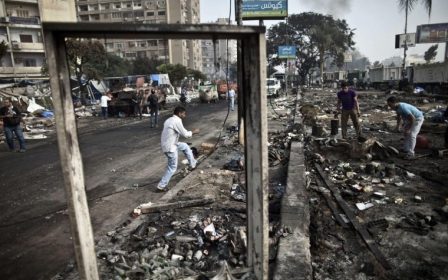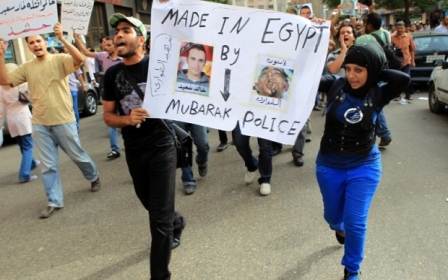Egypt marks Rabaa massacre anniversary with two narratives

Egypt on Friday marked the second anniversary of what has become known as the Rabaa massacre, when security forces violently cleared two protest camps in Cairo, staged in support of ousted President Mohamed Morsi.
The larger of the two sit-ins in support of Morsi, who was Egypt's first elected president before being overthrown by the army in a popularly backed coup on 3 July 2013, took place in Cairo’s Rabaa al-Adawiya Square.
The second sit-in was held at Nahda Square, before being attacked along with Rabaa Square by armed security forces on 14 August 2013, leading to the deaths of around 1,000 protestors.
A few days ahead of the second anniversary of the Rabaa massacre, government officials placed placards across Rabaa Square renaming it Hisham Barakat, after Cairo’s prosecutor general who was killed in a bomb attack in June.
The move has been seen by observers as an attempt to erase a collective memory of the violent crackdown on the hundreds of thousands of protesters who camped out in Cairo to protest against the military coup.
Rabaa Square became a symbol of resistance as the site where, according to HRW report, at least 1,000 Egyptians, predominantly supporters of the Muslim Brotherhood, were killed during the forcible dispersal of the protesters. The Egyptian government condemned the HRW report for including "misleading information".
The name Rabaa and its associated symbol of four-fingers on top of a yellow background was appropriated by resistance groups which continue to hold protests and challenge the current government led by Abdel Fatah al-Sisi, who staged the coup when he was head of the army and defence minister.
The Egyptian cabinet officially approved the renaming of Rabaa Al-Adawiya Square in July, almost three weeks after Barakat was killed in a Cairo bomb attack that targeted his car.
The request to change the name of the square was made in order to "erase the memory" of the Rabaa Al-Adaweya sit-in and "replace it with the everlasting memory of Barakat’s martyrdom as a respected judge", said head of the Judges Club Abdullah Fathy on the day of Barakat’s death.
Two years after the dispersal, the square is surrounded by several police checkpoints, while Rabaa mosque, after which the square was originally named, remains closed.
Despite being renovated, the mosque – which was the site for a makeshift hospital during the sit-in – and adjacent complex remain empty as high security measures have been maintain, passers-by told MEE.
Imposing narrative
While Nezar al-Sayyad, Professor of Architecture, Planning, Urban Design and Urban History at University of California, Berkeley sees the name change as a common practice adopted by all ruling elites in Egypt, he believes the name Hesham Barakat will not be easily adopted.
"I do not expect that Rabaa will disappear easily. Those who support the regime will be happy to adopt the name change but those who do not will continue to call it Rabaa," said Sayyad.
"When Mubarak came to power after Anwar Sadat’s assassination, he changed the name of Tahrir Square to Anwar Sadat Square, but no one ever used it."
"What is happening now with Rabaa is identical. Like every political regime, this government is attempting to erase what was there before and use a name that is more in line with its own policies and outlook," he added.
Nicholas Simcik-Arese, a geography DPhil candidate at the University of Oxford, agreed: "The destruction or appropriation of spaces of collective memory in a city is not a new phenomenon.
"Across history, but particularly in recent times in Egypt, there is an enduring and tried tradition of asserting power through erasure or imposition of a certain narrative in the city."
"[Rabaa] is clearly not just the name of a square or mosque alone but of a widespread movement that emerged as a result of events there and has taken a life and visual language of its own."
"Potent symbols and memories are resilient in ways that the state will always find difficult to match."
Deeper polarisation
Many Egyptians see the name change as a message from the government to the Muslim Brotherhood and its supporters that they are in power, especially that Barakat was responsible for handing a death sentence to hundreds of Muslim Brotherhood members.
"This [name change] is similar to kied el nissa [an Egyptian expression used when old women tease each other]," 21-year-old law student Abdel Rahman El-Dahshory told MEE.
"The government is just like an old woman trying to tease its rival. I was a participant in the 30th of June protest, but I know that Brotherhood members were killed there; why inflame their anger?" he added.
Thirty-two-year-old accountant Hassan Ibrahim agreed with Dahshory: "The government should be more responsible by taking decisions that are best for the whole country.
"A decision like this is more of a child’s. Furthermore, the Brotherhood never claimed responsibility of the assassination [of Hisham Barakat]; it is such a sensitive decision that should not be taken," he added.
While some Egyptians are deeply disturbed by the name change, others are more enthusiastic about it.
"The man [Barakat] spent his life fighting those terrorists [the MB]. He ought to be honoured in a proper way," said 63-year-old Abo Baker Abo el-Maati, a retired government official.
The differing opinions about the decision reflect a deepening polarisation in Egyptian society which observers say will not be helped by the name change.
"Irrespective of what people may feel about the MB or about the current government, most independent estimates calculate that about one-thousand humans were killed in Rabaa al- Adaweyya Square," said Simcik-Arese.
"Replacing this collective memory will likely be read by families of the dead as blaming them for the general prosecutor's assassination. It is hard to see how any healing or unity can come from what will undoubtedly be understood as a provocation," he said.
"Whether through the repeated demolition of encampments in Tahrir Square between 2011 and 2013 and abrupt construction of monuments or parking spaces in their place, the renaming of Mubarak Metro station, the enormous laser projection of the words 'this is not a coup' in English on the Mogamma, or the white washing of political graffiti on Mohammed Mahmoud Street, it is clear that erasing or covering the symbols of memory does not erase the memories themselves," he added.
Meanwhile in Britain, one day ahead of the second Rabaa massacre anniversary, human rights lawyers have warned that senior Egyptian officials visiting the UK could be arrested for crimes against humanity.
Additional reporting by Jamila Jorge from Cairo.
New MEE newsletter: Jerusalem Dispatch
Sign up to get the latest insights and analysis on Israel-Palestine, alongside Turkey Unpacked and other MEE newsletters
Middle East Eye delivers independent and unrivalled coverage and analysis of the Middle East, North Africa and beyond. To learn more about republishing this content and the associated fees, please fill out this form. More about MEE can be found here.




